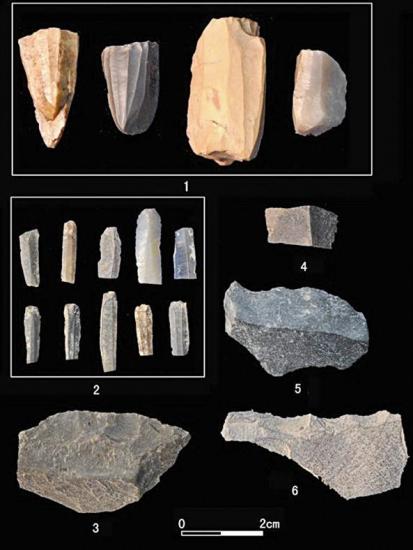Chinese Institute of Archaeology
Source - http://www.kaogu.cn/en/detail.asp?ProductID=4368
Jinsitai Site of Inner Mongolia is significant as a cave site in Northern China, located in the hills of the East Haierhan Mountain area in the west of Alatanhelisumu, East Wuzhumuqin Banner, Inner Mongol Autonomous Region, 20 kilometers to the border of China and Mongolia in north, 1401 meters in altitude.
During 2000 and 2001, the joint team from Inner Mongolia Institute of Cultural Relics and Archeology, Jilin Universtiy, Xilin Gol League Cultural Relics Station and Cultural Relics Administration of East Wuzhumuqin Banner, excavated this site twice, revealing the multiple culture layers of Bronze Age, Neolithic and Paleolithic Age, and finding remains of fire usage, as well as plenty of stone tools and animal fossils, etc. from Paleolithic period. To get a better knowledge of the date frame and more scientific data of this site, from July to August, 2012, Institute of Vertebrate Paleontology and Paleoanthropology of China, Museum of Inner Mongolia cooperated with Xilin Gol League Cultural Relics Station and Cultural Relics Administration of East Wuzhumuqin Banner together to re-excavated the Jinsitai Site, covering 10 square meters and 3.5 meters in depth, finding 8 cultural layers ranging from Late or End of Paleolithic Age to Bronze Age, unearthed over thousand stone wares and lots of animal fossils, pottery, polished bone tools and bead decorations, etc, gathering Carbon 14 dating samples from different layers. The overlapping cultural layers and many signs of fire usage suggested Jinsitai Cave Site was the one that ancient people lived for a long time and used more than once.

Excavation area
The 2012 excavation picked the balk of arranged unit left by the former excavations as exposed zone, which is less than 10 square meters. There were 10 cultural layers unearthed, dividing 8 cultural layers into 4 phases from early time to late preliminary, and yield plenty cultural relics,:
Phase One(Layer 7 to 8), belonging to the early stage of Late Paleolithic Age, represented by small flake stone culture, unearthed some small and simple flake, and some scraper produced by flake as blank ;
Phase Two (Layer 5 to 6), belonging to the mid stage of Late Paleolithic Age, few microlithic blade coexisted with blade stone, small blade stone and small flake tools, and many animal fossils was found as well.
Phase Three (Layer 3 to 4), belonging to the end of the Late Paleolithic Age, microlithic blade culture, lots of microlithic blade, microlithic core and some tools possessed by microlithic blade.
Phase Four(Layer 1 to 2), the mixed layer of Bronze Age and Neolithic Age, unearthed lots of ashes, fragments of animal bone, polished bones, bead decoration, as well as microlithic blade and core.

Stone artifacts from Jinsitai Site
The cultural features of Jinsitai site from Paleolithic Age were: 1) from early to late, developing from small flake culture and blade-small blade culture to microlithic blade culture, Jinsitai Site had continuous cultural sequence; 2) multiple materials, including Basalt, Andesite, Tuff, Obsidian, etc; 3) the product of microlithic blade in late Paleolithic Age lasted lasted for a rather long time, and the types of microlithic blade and core are rich, with some small microlithic core remaining; 4) in Late Paleolithic Age, the types of the tools mainly were side scraper, dent stone tools, and some incomplete blade remains suggested the existence of blade technique in this period; 5) there’s an obvious sign of fire usage in the layer.
The stages of Late Paleolithic Age in Northeast Asia were a hot subject in academia. Some scholars regarded the remains of stone blade and microlithic blade’s appearance as the marks of division early stage from late stage of Late Paleolithic Age, however, the space-time relation of stone blade and microlithic blade remains and technique connection were not clear. The continuous cultural layers in Jinsitai Site unearthed stone blade and microlithic blade remains, the comprehensive studies of which could contribute to divide the stage of Late Paleolithic Age of this place. Meanwhile, these materials had a great significance to the study on the technical connection of stone blade and microlithic blade, even the origin of microlithic technique, also providing important information on the technique origin of stone blade from Paleolithic Age and exploring its distribution and spreading path.
Besides, the location of Jinsitai Site is very important, because some relics shared great similarity with the one in Mongolia, even the ones in Lake Baikal, Russia, Far East. A comparison analysis between them would provide essential materials for migration of ancient people in late Pleistocene of this place.
In conclusion, the re-excavation of Jinsitai Site further revealed the rich cultural connotation of it, learned more about the human activities and living pattern of late Paleolithic in north border area of China. (Translator: Lang Langtian)